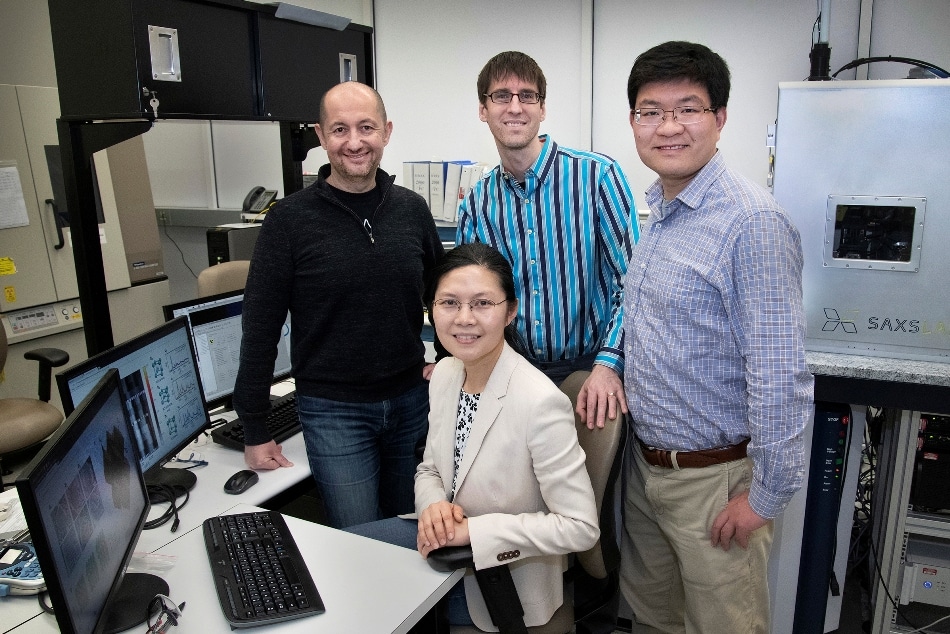May 20 2019
From the prehistoric pyramids to contemporary buildings, different three-dimensional (3D) structures have been created by packing together shaped objects. At the macroscale, the object’s shape is fixed and thus directs how they can be set. For instance, bricks coated with mortar retain their elongated rectangular shape. But at the nanoscale, the shape of objects can be altered to a certain extent when they are coated with organic molecules, such as surfactants (surface-active agents), polymers, and DNA. These molecules basically form a “soft” shell around otherwise “hard,” or stiff, nano-objects. When the nano-objects pack together, their initial shape may not be completely preserved as the shell is flexible—a type of nanoscale sculpturing.
 Brookhaven Lab scientists Fang Lu (sitting), (left to right, standing) Oleg Gang, Kevin Yager, and Yugang Zhang in an electron microscopy lab at the Center for Functional Nanomaterials. The scientists used electron microscopes to visualize the structure of nanocubes coated with DNA. (Image credit: Brookhaven National Laboratory)
Brookhaven Lab scientists Fang Lu (sitting), (left to right, standing) Oleg Gang, Kevin Yager, and Yugang Zhang in an electron microscopy lab at the Center for Functional Nanomaterials. The scientists used electron microscopes to visualize the structure of nanocubes coated with DNA. (Image credit: Brookhaven National Laboratory)
Presently, a team of researchers from the U.S. Department of Energy’s (DOE) Brookhaven National Laboratory and Columbia Engineering have demonstrated that cube-shaped nanoparticles, or nanocubes, coated with single-stranded DNA chains assemble into a rare “zigzag” arrangement that has never been seen before at the nanoscale or macroscale. Details of their discovery are published in the May 17th online issue of Science Advances.
“Nanoscale objects almost always have some kind of shell because we intentionally attach polymers to them during synthesis to prevent aggregation,” explained co-author Oleg Gang, leader of the Soft and Bio Nanomaterials Group at the Center for Functional Nanomaterials (CFN)—a DOE Office of Science User Facility at Brookhaven Lab—and professor of chemical engineering and applied physics and materials science at Columbia University. “In this study, we explored how changing the softness and thickness of DNA shells (i.e., the length of the DNA chains) affects the packing of gold nanocubes.”
Gang and the other team members—Fang Lu and Kevin Yager of CFN; Yugang Zhang of the National Synchrotron Light Source II (NSLS-II), another DOE Office of Science User Facility at Brookhaven; and Sanat Kumar, Thi Vo, and Alex Frenkel of Columbia’s Department of Chemical Engineering—found that nanocubes surrounded by thin DNA shells pack in a similar way to that anticipated on the macroscale, with the cubes set in neat layers oriented immediately above one another. But this basic cubic arrangement makes way for a very uncommon type of packing when the shell’s thickness is increased (i.e., when the shell becomes “softer”).
“Each nanocube has six faces where it can connect to other cubes,” explained Gang. “Cubes that have complementary DNA are attracted to one another, but cubes that have the same DNA repel each another. When the DNA shell becomes sufficiently soft (thick), the cubes arrange into what looks like a zigzag pattern, which maximizes attraction and minimizes repulsion while remaining packed as tightly as possible.
“This kind of packing has never been seen before, and it breaks the orientational symmetry of cubes relative to the vectors (directions of the x, y, and z axes in the crystal) of the unit cell,” said first author Fang Lu, a scientist in Gang’s group. “Unlike all previously observed packings of cubes, the angle between cubes and these three axes is not the same: two angles are different from the other one.”
A unit cell is the minutest repeating part of a crystal lattice, which is a collection of points in 3D space where the nanoparticles are located. Shaped nanoparticles can be oriented differently in relation to each other within the unit cell, such as by their faces, corners, or edges. The zigzag packing that the researchers noted in this research is a kind of nanoscale compromise wherein neither relative orientation “wins.” Instead, the cubes find the ideal arrangement to co-exist in an ordered lattice based on whether they have the complementary or same DNA (that is, repelling or attracting each other accordingly).
Here, two different lattice types can happen: body-centered tetragonal (BCT) and body-centered cubic (BCC). Both BCT and BCC have analogous placements of particles in the center and corners of the cubes, but BCC has unit cell sides of identical lengths while BCT does not.
To envisage the shape of the cubes and their packing behavior, the researchers used an arrangement of electron microscopy at the CFN and small-angle X-ray scattering (SAXS) at the earlier X9 beamline of NSLS and the Complex Materials Scattering beamline of NSLS-II. The electron microscopy studies necessitate that the materials are removed from the solution, but SAXS can be carried out in situ to offer more comprehensive and precise structural information. In this research, the scattering data were useful in exposing the distances between particles, the symmetries, and orientations of particles in the 3D nanocube structures. Theoretical calculations done by the Kumar Group at Columbia verified that the zigzag arrangement is conceivable and rationalized why this kind of packing was taking place according to the properties of the DNA shells.
The team is currently keen on determining whether soft-shelled nano-objects that are not cubes or have more than one shape also pack together in unanticipated ways.
An understanding of the interplay between shaped nano-objects and soft shells will enable us to direct the organization of objects into particular structures with desired optical, mechanical, and other properties.
Sanat Kumar, Department of Chemical Engineering, Columbia University